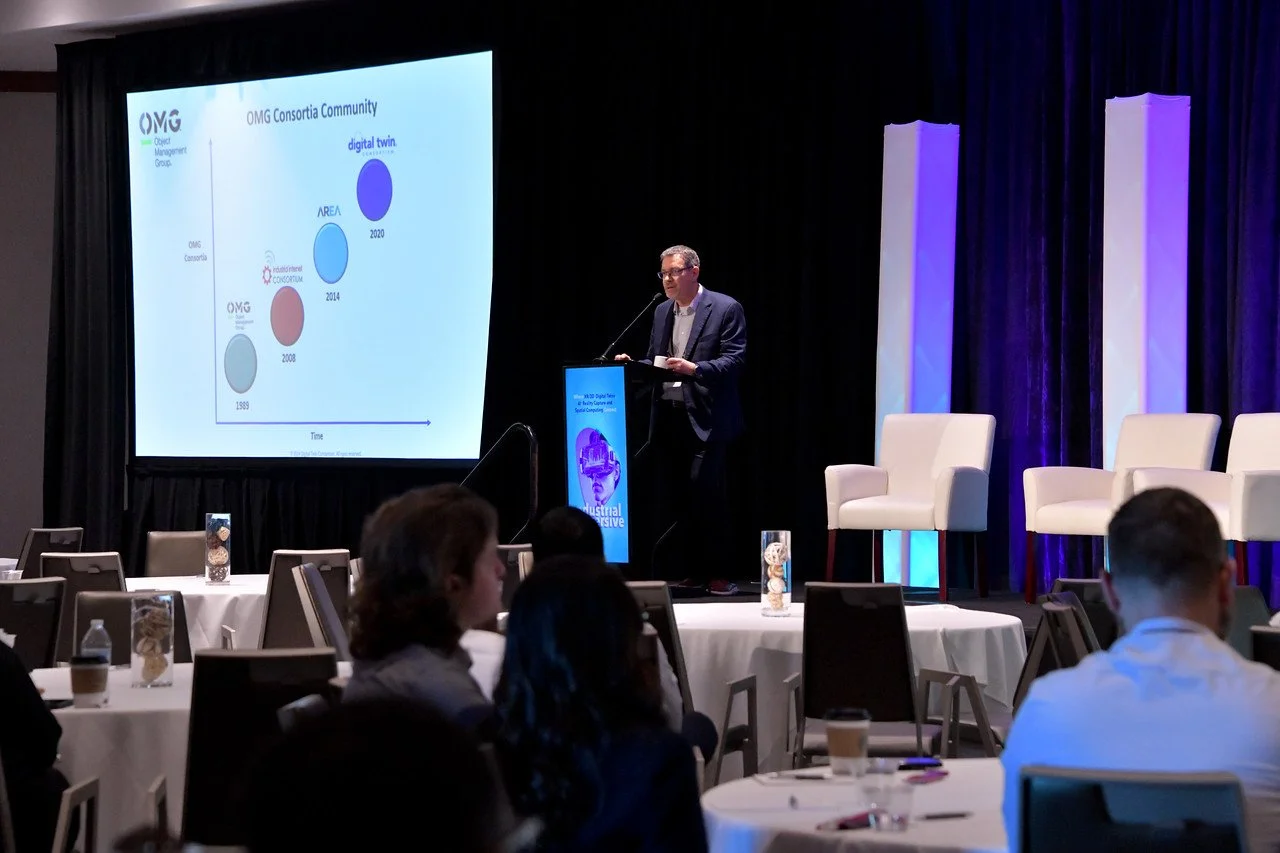From Intelligent to Generative: The Evolution of Digital Twins
/At our 2025 Industrial IMMERSIVE, Dan Isaacs of the Digital Twin Consortium took the stage to chart the rapidly advancing journey of digital twin technology—from its intelligent past to its generative future. His session, “Evolution of the Digital Twin: From Intelligent to Generative,” offered a deep dive into the role digital twins are playing across industries and what lies ahead as generative AI and autonomous agents transform their capabilities.
Foundations: Building a Global Ecosystem for Digital Twins
Isaacs started by sharing information about the Digital Twin Consortium (DTC), which launched nearly five years ago with founding members like Microsoft, Dell, and Ansys. Now with over 200 members—ranging from startups to industry giants like BP, NASA, Pfizer, ExxonMobil, and Schlumberger—the consortium is dedicated to cutting through the hype and showcasing the real-world value of digital twins.
As Isaacs put it, “Digital twins are really being recognized as providing value across virtually every industry. In fact, I've looked—I can't find one industry that can't benefit from the value that a digital twin can provide.”
The DTC isn’t just about evangelism; it’s actively building standards, best practices, and frameworks. They’ve launched a reference library of use cases and case studies, developed a capabilities framework (likened to a periodic table of digital twin features), and are now spearheading global testbed initiatives to validate technologies in live environments.
What Is a Digital Twin Today?
The DTC defines digital twins as: “virtual representations of real-world entities and processes synchronized at a specified frequency and fidelity.” These digital replicas are a cornerstone of transformation in industries ranging from manufacturing to energy to agriculture.
According to Isaacs, “A true digital twin and the true value comes from this closed-loop capability.” That loop—constant synchronization between the physical and virtual—creates opportunities for simulation, prediction, and optimization.
The Evolution: From Passive to Autonomous
Referencing the work of Dr. Michael Grieves (the “father” of digital twins), Isaacs described a key conceptual shift:
Traditional Digital Twins are passive—programmed to respond to known triggers.
Intelligent Digital Twins are goal-seeking—able to optimize and predict based on real-time data.
Generative Digital Twins take this further, using multimodal AI to understand data and act with increasing autonomy.
Isaacs emphasized the role of agents—autonomous software entities that can observe, reason, self-organize, and take action. “They can plan, they can observe, they can reflect, they can optimize between themselves, they can organize... then they can take action and you can have the human in the loop making that final basis decision.”
He showcased live examples from consortium members:
Infrastructure agents managing energy-intensive pumping schedules
Automotive testing environments reducing validation time by over 300%
NASA and LSU’s use of multi-agent systems in infrastructure monitoring
Reducing Cognitive Load, Increasing Impact
One compelling case involved an EV battery factory struggling with high operator cognitive load. Isaacs described how generative digital twins, populated with expert agents in thermal management, reliability, and operations, could drastically reduce that burden. “Now you're reaching a point where you can actually see areas where these agents provide significant value. They’re reducing the cognitive load, allowing the subject matter experts to think about the strategic side.”
What’s Next: Testbeds and Digital Engineering
To accelerate the generative evolution, the DTC has launched a new testbed initiative, enabling members and non-members alike to showcase their technologies in real-world deployments. It ties together everything the consortium has developed—from its maturity models and capabilities frameworks to its digital thread strategies.
As Isaacs put it, the future of digital twins lies in their convergence with advanced model-based systems engineering and artificial intelligence: “This is about being able to bring that collective intelligence to not only understand and increase the awareness of the value digital twin provides, but accelerate that adoption.”
Final Thought
Isaacs closed his session by emphasizing the role of the Digital Twin Consortium in uniting cross-industry efforts. “It’s innovation, it’s collaboration, it’s the thought leadership that we bring out and that actually helps to grow more opportunities for our members.”
As industries lean into autonomous operations and generative AI, the digital twin is no longer just a reflection—it’s a decision-maker, a strategist, and a catalyst for transformation.
Learn more about the Digital Twin Consortium on their website.
Watch this and other Industrial IMMERSIVE sessions on demand.



